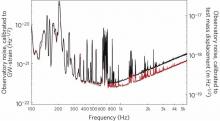
Abstract
Around the globe several observatories are seeking the first direct detection of gravitational waves (GWs). These waves are predicted by Einstein’s general theory of relativity and are generated, for example, by black-hole binary systems. Present GW detectors are Michelson-type kilometre-scale laser interferometers measuring the distance changes between mirrors suspended in vacuum. The sensitivity of these detectors at frequencies above several hundred hertz is limited by the vacuum (zero-point) fluctuations of the electromagnetic field. A quantum technology—the injection of squeezed light—offers a solution to this problem. Here we demonstrate the squeezed-light enhancement of GEO 600, which will be the GW observatory operated by the LIGO Scientific Collaboration in its search for GWs for the next 3–4 years. GEO 600 now operates with its best ever sensitivity, which proves the usefulness of quantum entanglement and the qualification of squeezed light as a key technology for future GW astronomy.